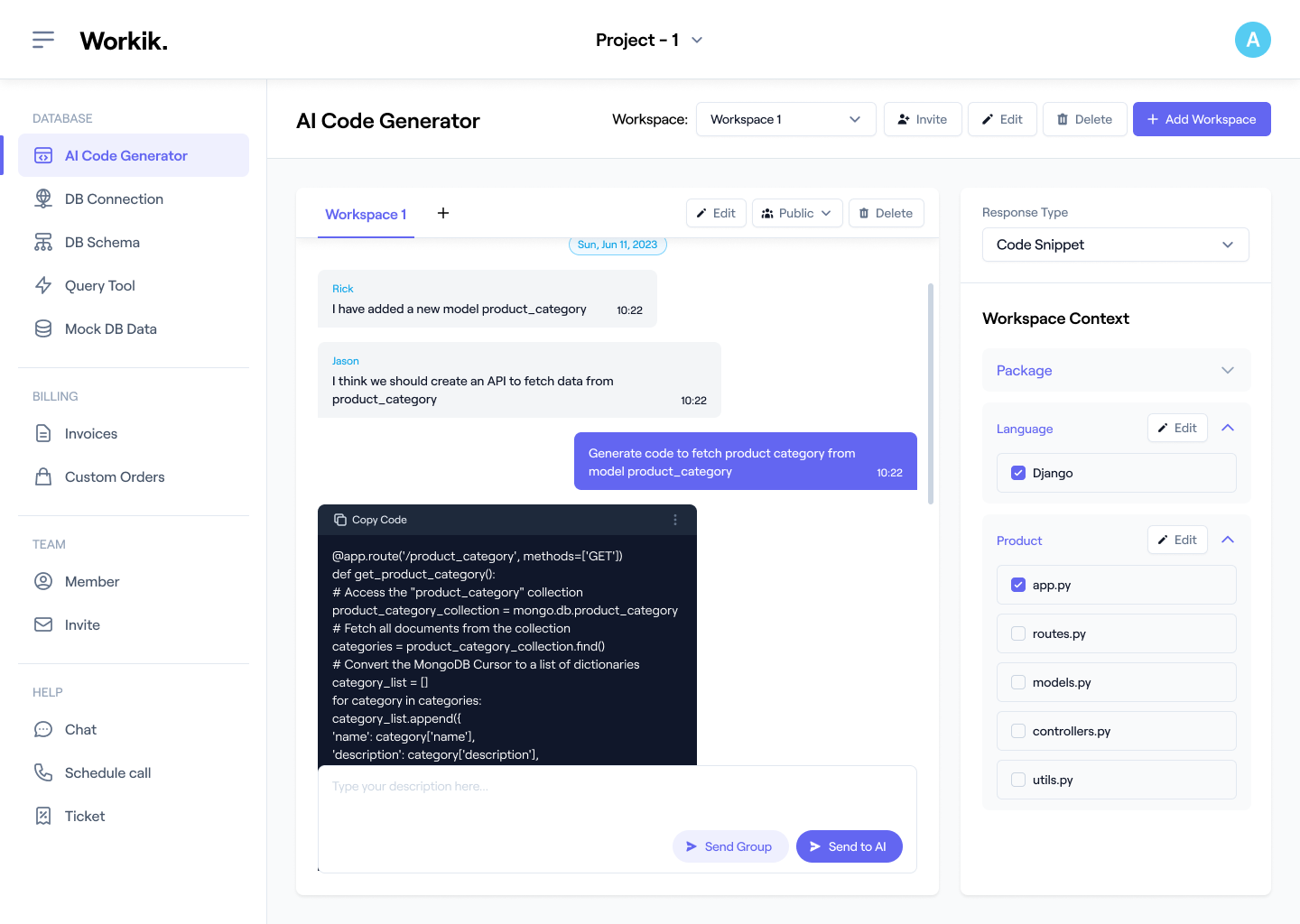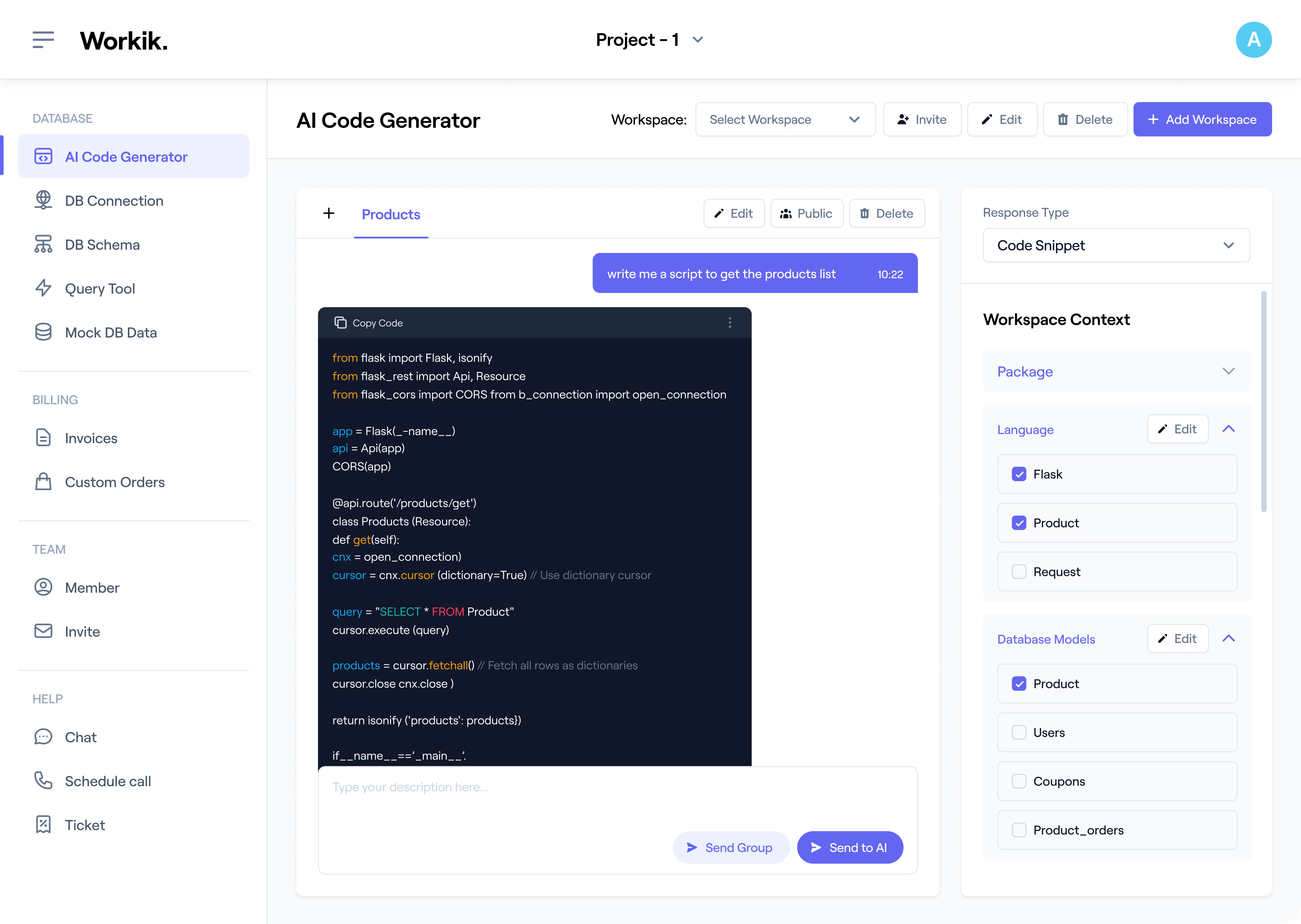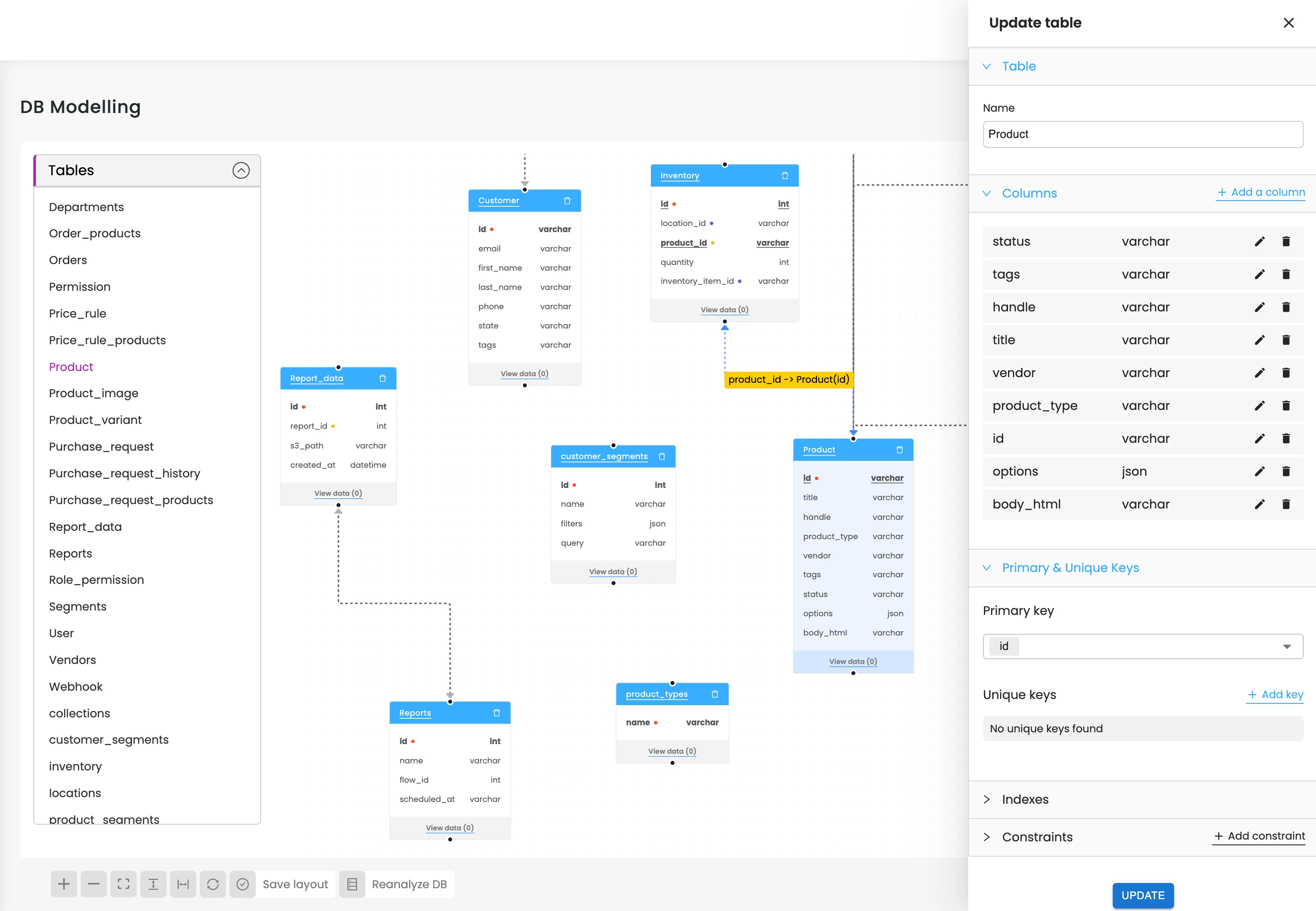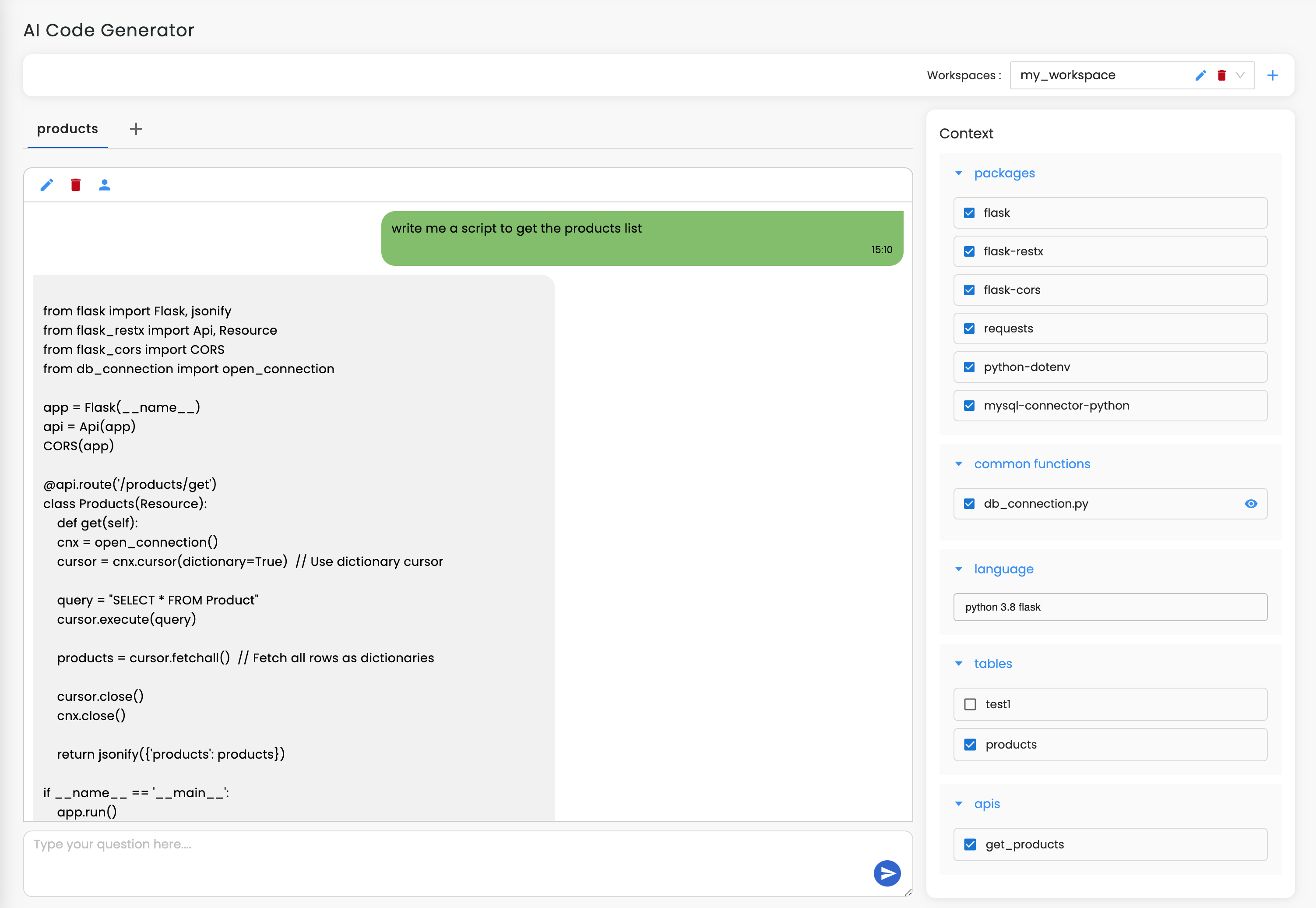
Join our community to see how developers are using Workik AI everyday.
Features

Automate OTP Generation
AI creates secure TOTPs and HMAC-based OTPs, ready to integrate with Google Authenticator or Twilio APIs.

Secure Token Encryption
Use AI to encrypt keys and tokens with AES or RSA, ensuring compliance with modern security standards.

Integrate Backend Seamlessly
AI simplifies adding 2FA to frameworks like Django, Node.js, and more with fast code generation.

Build Cross-Platform 2FA Modules
AI generates 2FA components for web, mobile (React Native), and desktop (Electron) with precision.
How it works
Sign up using Google or manually enter your details to access Workik’s AI-driven 2FA tools and features.
Link your GitHub, GitLab, or Bitbucket repositories. Specify frameworks like Django, Node.js, or more, and integrate API tools like Twilio Authy or Google Authenticator for tailored AI assistance.
Use AI to generate secure OTPs, encryption modules, and 2FA workflows. AI helps debug issues, validate token lifespans, and optimize 2FA integration seamlessly.
Invite your team to review and refine the 2FA setup collaboratively. Share workspaces, assign roles, and leverage AI insights to test and enhance authentication for maximum security.


Expand
.png)
.png)
Expand


Expand


Expand


Expand


Expand


Expand


TESTIMONIALS
Real Stories, Real Results with Workik
Workik’s AI streamlined 2FA integration with secure OTPs and reliable encryption for our Node.js app.

Jeff Carter
Senior Backend Developer
Workik’s AI made 2FA setup simple and efficient, saving hours on my first project.

Serena Lee
Junior Web Developer
Workik’s AI ensures secure token lifespans and compliance across platforms seamlessly.

Martin Evans
DevOps Engineer
What are some popular use cases for Workik’s AI-powered Two-Factor Authentication (2FA) Code Generator?


Some popular use cases of the 2FA Code Generator include but are not limited to:
* Generating secure TOTP and HMAC-based OTPs for login systems.
* Creating robust two-step verification flows for web and mobile apps.
* Automating 2FA implementation with tools like Google Authenticator and Twilio Authy.
* Encrypting token data using AES or RSA standards for advanced security.
* Developing cross-platform 2FA modules for frameworks like React Native and Django.
* Simplifying API integrations with prebuilt 2FA workflows for applications.
What kind of contexts can I add to Workik’s AI for Two-Factor Authentication (2FA) Code Generator?


Workik offers versatile context-setting options for 2FA code generation, allowing users to:
* Sync repositories from GitHub, GitLab, or Bitbucket to streamline integration.
* Define frameworks like Node.js, Django, or Laravel for backend customization.
* Add API integration details for services like Twilio Authy or Duo Security.
* Import database schemas for secure token storage using PostgreSQL or MongoDB.
* Specify encryption protocols like AES or RSA for secure key management.
* Upload QR code templates or custom designs for tailored 2FA user experiences.
How does Workik AI assist in testing 2FA workflows in CI/CD pipelines?


Workik AI generates automated test cases for 2FA workflows, covering OTP validation, token expiration, and API responses. It integrates with tools like Postman to simulate API requests and Selenium to validate user flows across browsers. These tests ensure seamless functionality and security in every CI/CD deployment.
Can Workik generate backup and recovery options for 2FA users?


Yes, Workik’s AI generates fallback mechanisms like recovery codes or email verification. If a user loses access to their authentication app, the system provides secure backup codes or a one-time recovery link, ensuring security without disrupting access.
Can Workik’s AI help with biometric authentication?


Yes, Workik integrates biometric libraries like TouchID and FaceID alongside OTPs, enabling multi-factor setups with biometrics as one layer and 2FA as another for enhanced security.
Can Workik help integrate hardware tokens like YubiKeys?


Yes, Workik can assist in integrating hardware-based 2FA systems, such as YubiKeys. AI generates code that aligns with FIDO2 or U2F protocols, making it easy to incorporate hardware tokens into your security infrastructure.
How does Workik help prevent phishing attacks in 2FA systems?


Workik generates phishing-resistant 2FA workflows by supporting modern authentication protocols like FIDO2 and WebAuthn. These protocols use public-key cryptography, ensuring credentials are never exposed to phishing sites or intermediaries.
Can Workik create 2FA workflows for IoT devices?


Yes, Workik’s AI generates lightweight 2FA code suitable for IoT platforms. For example, it can build token-based workflows for smart home devices or industrial IoT systems, ensuring secure user authentication across connected ecosystems.
Generate Code For Free

Two-Factor Authentication: Question and Answer
Two-factor authentication (2FA) is a security mechanism requiring users to verify their identity through two independent factors: something they know (password) and something they have (OTP or hardware token). It strengthens account security by adding an extra layer of protection, making unauthorized access significantly harder.
Frameworks and tools commonly used for implementing 2FA include:
Frameworks:
Django, Node.js, Laravel, Spring Boot
OTP Libraries:
PyOTP, PHPGangsta/GoogleAuthenticator, OTPAuth
APIs:
Twilio Authy, Duo Security, Google Authenticator API
Encryption:
OpenSSL, bcrypt, AES, RSA
Frontend Tools:
React, Angular, Vue.js for 2FA UI
Testing:
Selenium for flow validation, Postman for API testing
Databases:
PostgreSQL, MongoDB for secure token storage
Popular use cases of Two-Factor Authentication (2FA) include but not limited to:
Login Security:
Adding OTPs or biometric verification for secure user authentication.
Payment Gateways:
Ensuring secure transactions via token-based approvals.
Enterprise Systems:
Protecting sensitive data with 2FA in SSO setups.
E-commerce:
Securing customer accounts during checkouts and profile updates.
Healthcare:
Safeguarding patient data in HIPAA-compliant systems.
Banking Apps:
Strengthening security with time-sensitive OTPs or push notifications.
Career roles in Two-Factor Authentication (2FA) include Security Engineer, Backend Developer, Full-Stack Developer, DevOps Engineer, and API Developer, focusing on designing secure 2FA systems, integrating workflows in Django or Laravel, deploying via CI/CD, and managing login APIs for robust authentication.
Workik AI streamlines 2FA implementation by automating critical tasks like:
Code Generation:
Generates secure OTP workflows, QR codes, encryption logic, and reusable 2FA code.
Backend Integration:
Provides tailored 2FA code for frameworks like Node.js, Django, and Laravel.
Debugging:
Identifies and resolves token validation, expiration, and flow errors.
Optimization:
Refines 2FA workflows for performance, scalability, and reduced latency.
Multi-Platform Support:
Builds 2FA modules for web, mobile, and desktop applications.
API Integration:
Simplifies connections with Twilio Authy, Google Authenticator, and Duo Security.
Testing:
Generates test cases for edge scenarios like token replay and expired OTPs.
Documentation:
Produces detailed guides for deploying and managing secure 2FA systems.
Explore more on Workik
Get in touch
Don't miss any updates of our product.
© Workik Inc. 2025 All rights reserved.

